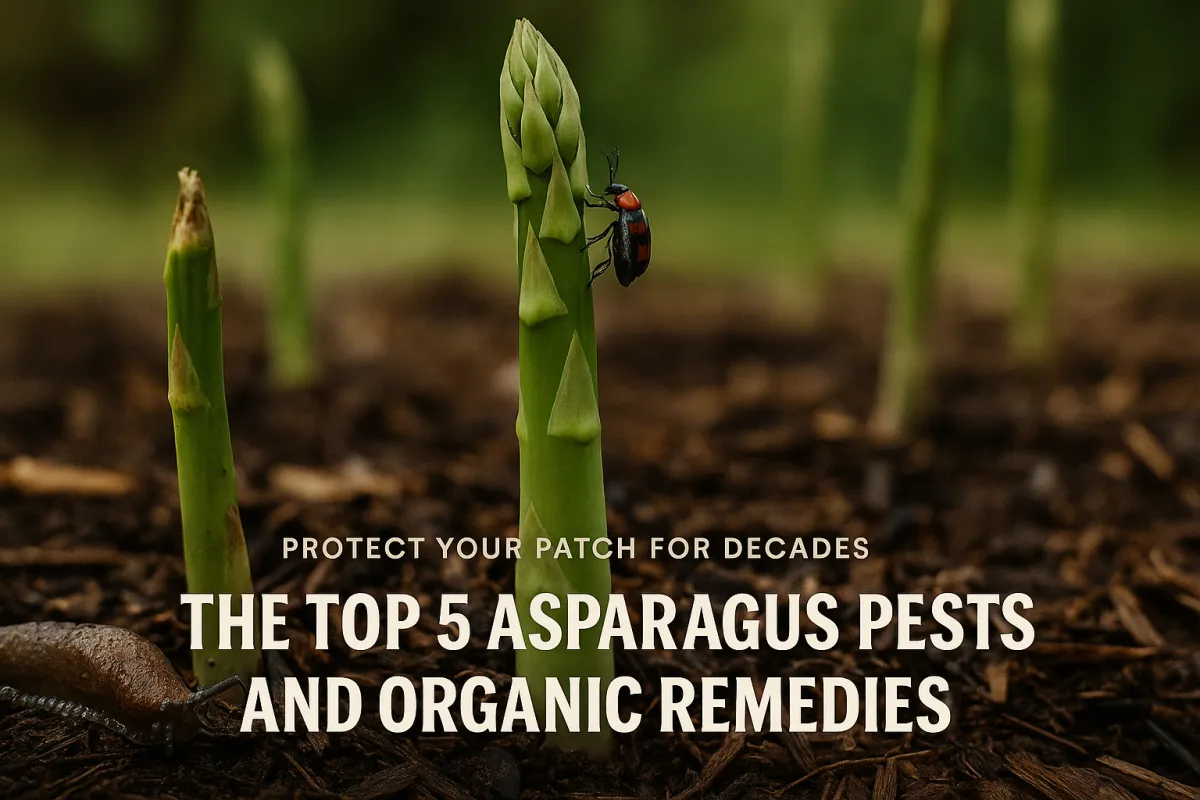
The Top 5 Asparagus Diseases and Organic Prevention
A Hard Lesson in Asparagus Beds
When I planted my first asparagus patch, I thought I was set for life. Everyone told me asparagus was the crop you “plant once and harvest forever.” That sounded good to me. I put the crowns in the ground, dreamed about spring harvests, and then waited. By the third year, my plants were producing — but not the way I imagined. The ferns yellowed too early, the spears thinned out, and I lost plants before the season was done.
That’s when I learned: asparagus isn’t bulletproof. It’s a perennial investment that should last 10 to 15 years, but only if you set it up to withstand disease from the beginning. Lose the crowns, and you lose years of harvest.
Here are the top five asparagus diseases I’ve seen or battled myself — and the organic prevention steps that will keep your patch thriving.
1. Rust: Resistant Varieties and Spacing
Rust shows up as orange pustules on asparagus ferns, usually later in the season. Left unchecked, it weakens the plant, causing early dieback and fewer spears the following spring.
How to Prevent Rust
Plant resistant varieties — newer cultivars like ‘Jersey Supreme’ and ‘Millennium’ offer better defense.
Space crowns wide — give at least 18 inches between plants and 4–5 feet between rows for good airflow.
Remove diseased ferns — cut them down in late fall and compost only if your pile runs hot. Otherwise, discard.
Grandma’s Tip: “Don’t crowd your plants — they need to breathe just like you do.”
2. Fusarium Wilt: Crop Rotation and Soil Health
This one’s a long-term problem. Fusarium fungi live in the soil for years, attacking roots and crowns. You’ll notice yellowing ferns, weak spears, and stunted plants. It thrives in stressed soil and spreads fast once it sets in.
How to Prevent Fusarium
Rotate crops — after 8–10 years, don’t replant asparagus in the same spot.
Build soil health — steady compost applications, cover crops, and balanced nutrients keep crowns strong.
Avoid stress — don’t overharvest spears; stop cutting by early summer to let the ferns recharge.
Pro Tip: Fusarium loves stressed plants. Healthy soil and light harvesting early in the plant’s life go a long way.
3. Crown Rot: Drainage and Soil Prep
Crown rot is one of the most discouraging diseases. If you dig up a failing asparagus crown and find mushy, blackened roots, you’re looking at it. The biggest culprit is poor drainage, especially in clay soils.
How to Prevent Crown Rot
Choose a well-drained site — asparagus doesn’t forgive “wet feet.”
Improve soil texture — mix in sand, compost, and organic matter before planting.
Use raised beds if needed — in heavy soils, this is often the only long-term fix.
Region-Specific Note: If you’re in the Midwest or Northern states with clay-heavy soil, invest the time up front to prepare. A poorly drained asparagus bed will fail in just a few years.
4. Purple Spot: Sanitation and Airflow
Purple spot is a fungal disease that leaves sunken purple lesions on asparagus spears and ferns. It doesn’t usually kill the plant, but it ruins market quality and can weaken growth if it spreads.
How to Prevent Purple Spot
Clean up fern debris in fall — don’t leave infected ferns on the ground.
Allow airflow — space rows and avoid thick weed growth that traps moisture.
Mulch with straw or wood chips to reduce soil splash carrying spores onto spears.
Grandma’s Tip: “A clean garden in the fall saves you headaches in the spring.”
5. Damping-Off in Seedlings
If you’ve ever started asparagus from seed, you might have seen damping-off. Tiny seedlings sprout and then collapse at the soil line, as if cut by a thread. This fungal issue thrives in wet, stagnant conditions.
How to Prevent Damping-Off
Start with sterile seed-starting mix — don’t reuse garden soil in trays.
Avoid overwatering — keep soil moist, not soggy.
Provide airflow and sunlight — a small fan in a greenhouse or open window makes all the difference.
Region Note: This shows up more often in humid southern greenhouses, but it can strike anywhere seed trays stay wet too long.
Faith Touch
Asparagus is a crop that teaches patience. You don’t get a harvest the first year, sometimes not even the second. And you only reap the benefits if you protect it from what threatens it along the way.
That reminds me of Galatians 6:9 (NKJV): “Let us not grow weary while doing good, for in due season we shall reap if we do not lose heart.” Guarding your asparagus is a picture of stewardship — tending what’s been planted so it thrives in time.
Closing: Building a Disease-Resilient Asparagus Bed
The five main asparagus diseases — rust, fusarium wilt, crown rot, purple spot, and damping-off — can all be managed with prevention. Think of it like insurance: good spacing, healthy soil, clean beds, and proper drainage will carry your asparagus patch for a decade or more.
Take the time now to build your asparagus bed right. Years from now, when you’re pulling in armloads of spears every spring, you’ll be glad you did.
👉 Download the Asparagus Disease Prevention Checklist to keep on hand for planting and seasonal care.


Facebook
Instagram
X
Youtube